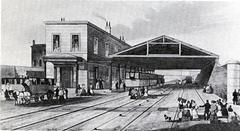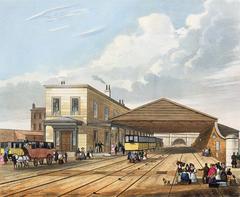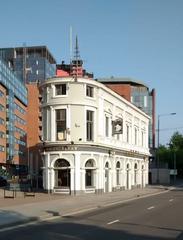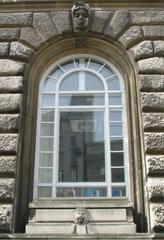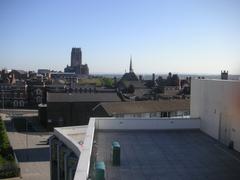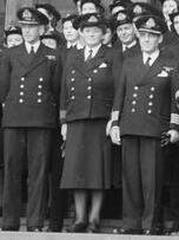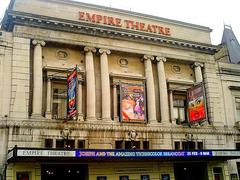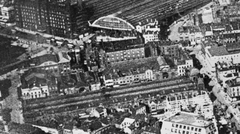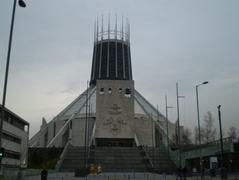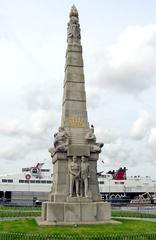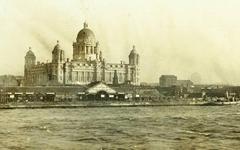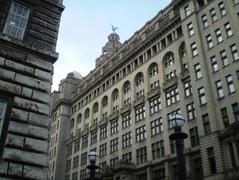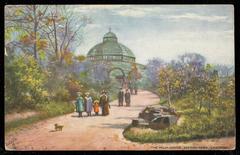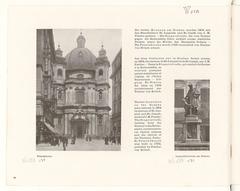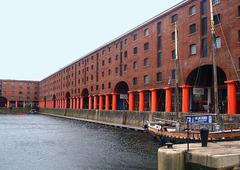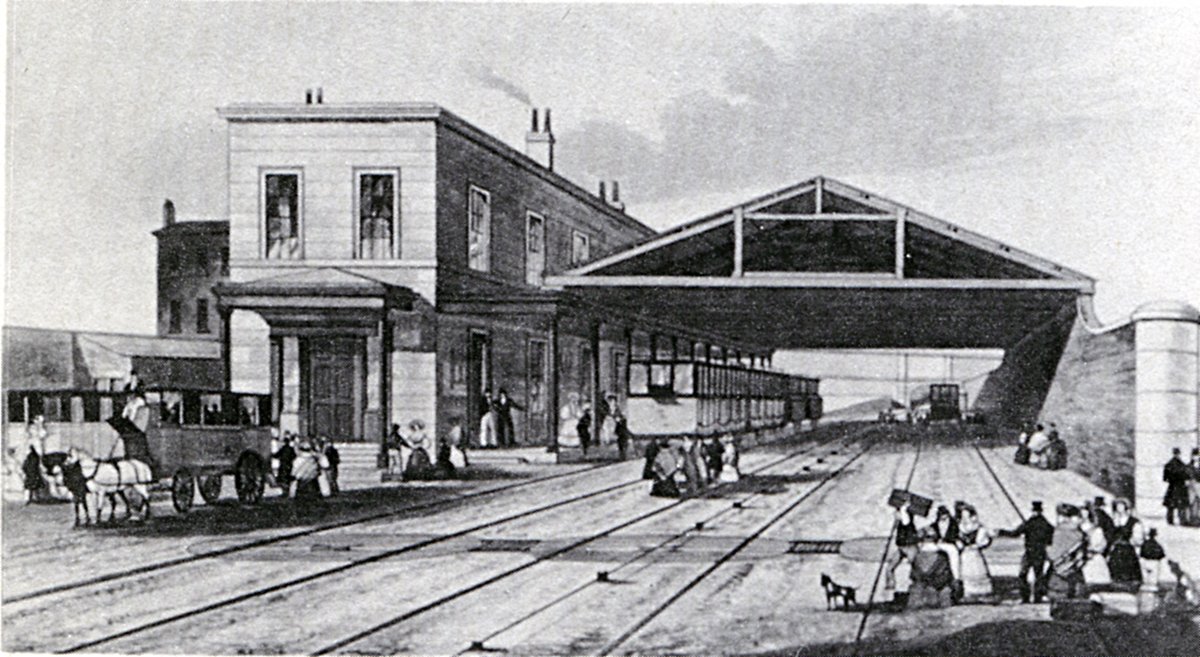
Crown Street Railway Station Liverpool: Visiting Hours, Tickets, and Historical Sites Guide
Date: 15/06/2025
Introduction: Crown Street Railway Station—A World First
Crown Street Railway Station in Liverpool, United Kingdom, occupies a landmark position in global transportation history as the world’s first dedicated intercity passenger railway terminus. Opened in 1830 as the Liverpool terminus of the revolutionary Liverpool and Manchester Railway (L&MR), Crown Street marked a decisive move from canals and horse-drawn travel to steam-powered rail, igniting the Industrial Revolution and influencing urban development in Britain and beyond. Although passenger services transferred to Lime Street Station in 1836 and the original buildings were later demolished, Crown Street’s legacy endures through remnants like the historic Wapping Tunnel—the world’s first city-underpass railway tunnel—and its rebirth as Crown Street Park.
Today, visitors can experience this pivotal heritage site through open public spaces, interpretive signage, heritage trails, and guided walks. The station’s pioneering engineering, including the endless rope haulage system and its role in the legendary Rainhill Trials, continues to attract railway enthusiasts and history seekers. Nearby museums such as the Victoria Gallery & Museum house artifacts and records preserving the story of Crown Street, while local heritage groups regularly organize tours to enrich visitor understanding.
Whether you are looking to explore Crown Street Park during its daylight hours, delve into the marvels of early railway engineering, or immerse yourself in Liverpool’s industrial past, this guide provides up-to-date information on opening hours, accessibility, transport, and nearby attractions. For current schedules, map details, and travel tips, consult official resources like Visit Liverpool and Disused Stations.
Step back into the dawn of the railway age, discover Liverpool’s rich transport heritage, and visit the site where modern intercity rail travel began.
Table of Contents
- Introduction
- Historical Overview
- Visiting Crown Street Railway Station
- Crown Street Park: Transformation and Features
- Tours and Learning Opportunities
- Nearby Attractions
- Preservation and Future Prospects
- Frequently Asked Questions (FAQs)
- Conclusion and Call to Action
- References
Historical Overview
The World’s First Passenger Railway Station
Opened on September 15, 1830, Crown Street Railway Station was the terminus for the world’s first scheduled intercity passenger railway—the Liverpool and Manchester Railway. This innovation shifted travel from slow, labor-intensive means to efficient, steam-powered rail, catalyzing industrial and urban growth (Victorian Web; Old Liverpool Railways).
Engineering Innovations
Crown Street’s connection to Liverpool’s city center was achieved via the Wapping Tunnel, the world’s first tunnel bored under a major city for rail purposes. Spanning 1.26 miles (2.03 km), it featured an endless rope haulage system powered by a stationary engine at Moorish Arch—an engineering marvel preceding widespread locomotive use (Victorian Web).
The Rainhill Trials and Locomotive Development
The 1829 Rainhill Trials, a competition for the best locomotive design, saw George Stephenson’s “Rocket” triumph and set the template for future engines. The adoption of Rocket’s technology at Crown Street and throughout the L&MR helped cement Liverpool’s position at the forefront of railway innovation (Victoria Gallery & Museum).
Economic and Social Impact
The L&MR represented a massive capital investment, with costs exceeding £1,000,000 in its inaugural year, linking two industrial giants. The first public journey covered 31 miles in under two hours, transforming travel times and accessibility. After 1836, Crown Street transitioned into a coal depot, supporting Liverpool and Manchester’s industrial expansion (Victorian Web; Old Liverpool Railways).
Visiting Crown Street Railway Station: Hours, Access, and Tickets
Visiting Hours and Access
The original station is gone, but the site now forms Crown Street Park—a public green space open year-round during daylight hours. There is no admission fee. Visitors can view the entrance to the historic Wapping Tunnel and explore interpretive panels detailing the site’s significance.
- Location: East of Liverpool city centre, adjacent to the University of Liverpool.
- Access: Reachable by foot, bike, bus, or short taxi ride from Lime Street Station. Wheelchair accessible with paved and gravel paths.
Tickets and Entry
Access to Crown Street Park and the heritage trail is free. Museums such as the Victoria Gallery & Museum, which hold related collections, may charge a small entry fee or request donations—check their websites for details.
Facilities
Crown Street Park offers benches and walking paths. It does not have dedicated visitor centers or restrooms; amenities can be found in the nearby university and Georgian Quarter areas.
Getting There and Transport Links
- Nearest Station: Liverpool Lime Street (about 15 minutes’ walk).
- Bus: Stops on Oxford Street and Grove Street serve the area.
- Car: Limited on-street parking; public transport is recommended.
- Bike: Accessible via cycle lanes; racks nearby.
Crown Street Park: Transformation and Features
From Railway Terminus to Urban Green Space
After ceasing passenger services in 1836 and goods operations in 1972, the site was landscaped in the 1980s into Crown Street Park (Disused Stations). Today, the park offers lawns, mature trees, and walking paths contrasting with its industrial past.
Remnants and Visible Features
- Tunnel Portals: The 1849 tunnel portal, visible at the park’s eastern boundary, is a rare surviving feature (Disused Stations).
- Railway Alignment: The park’s elongated shape and embankments follow the former railway’s route and can be traced with historical maps (Grace’s Guide).
- Interpretive Signage: Panels provide historical context and images of the original station and railway cutting.
Access and Orientation
The park is easily navigable with multiple entrances from Crown Street and Falkner Street. The flat terrain and paved paths make it accessible for visitors of all abilities.
Visitor Experience and Practical Tips
- What to Bring: Comfortable footwear, water, and snacks.
- Best Times to Visit: Spring and summer for pleasant weather, though the park is accessible all year.
- Photography: Excellent opportunities for capturing the tunnel entrance and the park’s landscape.
- Safety: Visit during daylight and be aware of surroundings.
- Dog-Friendly: The park welcomes dogs.
Tours and Learning Opportunities
Guided Tours and Heritage Walks
Local heritage groups and societies periodically offer guided walks focused on Liverpool’s railway history, including Crown Street Park. These tours provide deeper historical insight and are listed on Visit Liverpool or local event pages.
Museum Collections and Public Education
The Victoria Gallery & Museum and Liverpool Free Public Library house artifacts and documents from the early railway era, available for public viewing and research (Victoria Gallery & Museum; Victorian Web).
Nearby Attractions
Enhance your visit by exploring other iconic Liverpool sites:
- Lime Street Station: The grand Victorian successor to Crown Street, still in operation.
- Museum of Liverpool: Explores the city’s industrial and transport story.
- Merseyside Maritime Museum: Chronicles Liverpool’s maritime legacy.
- Edge Hill Station: One of the world’s oldest working stations, just a short walk away.
- Victoria Gallery & Museum: Offers exhibitions on local history and the railway’s impact.
- Liverpool Waterfront: A UNESCO World Heritage Site with cultural venues and scenic views.
Preservation and Future Prospects
Crown Street Park is managed for recreation, but its historical significance continues to attract heritage groups and researchers. No major redevelopment is planned, but ongoing maintenance and occasional heritage events ensure its story remains accessible (Disused Stations).
Frequently Asked Questions (FAQs)
Q: Can I visit the original Crown Street Railway Station building?
A: The original structure is demolished, but the site and tunnel portal are accessible within Crown Street Park as part of heritage trails.
Q: Are guided tours available?
A: Yes—local heritage groups and museums occasionally offer tours. Check Visit Liverpool for current listings.
Q: Is there an admission fee?
A: No—entry to Crown Street Park and the heritage trail is free. Some nearby museums may charge admission.
Q: Is the park accessible for people with disabilities?
A: Yes, the park has flat, paved paths. For specific accessibility enquiries, contact Visit Liverpool Accessibility Toolkit.
Q: Can I enter the Wapping Tunnel?
A: The tunnel is closed to regular public tours but may be open for special heritage events.
Conclusion and Call to Action
Crown Street Railway Station’s site represents the birthplace of modern intercity rail travel and a defining moment in Liverpool’s and Britain’s industrial history. Its transformation into Crown Street Park offers a peaceful yet evocative space to reflect on the pioneering spirit that shaped global transportation.
Plan your visit today! For more details, check Visit Liverpool for current opening hours, accessibility, and tour options. Download the Audiala app for guided audio tours, and follow our social channels for updates on Liverpool’s historical sites and events.
Experience Liverpool’s revolutionary railway heritage at Crown Street Park—the landmark that changed transportation forever.
References
- Visit Liverpool
- Victoria Gallery & Museum
- Disused Stations
- Grace’s Guide
- Old Liverpool Railways
- Liverpool City Region Combined Authority
- Visit Liverpool Accessibility Toolkit
- Liverpool Weekender Guide
- Crown Street Park Details
- Wikipedia: Crown Street railway station
- Wikipedia: Liverpool Lime Street railway station
